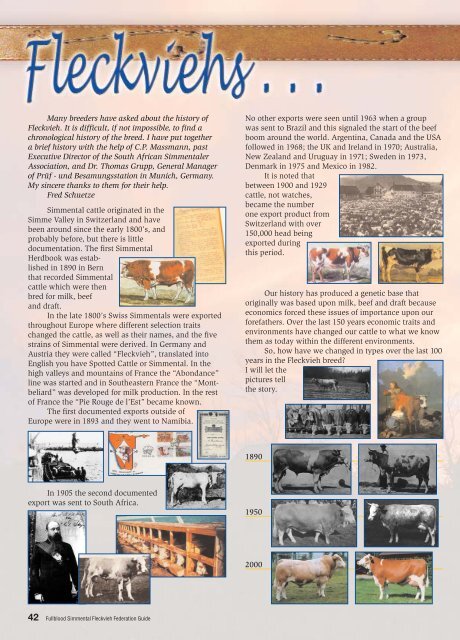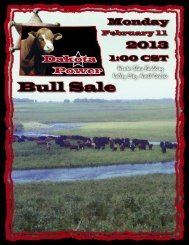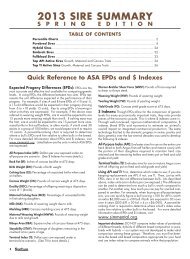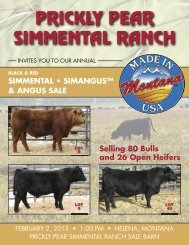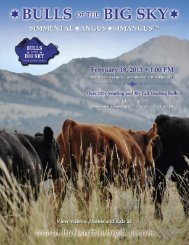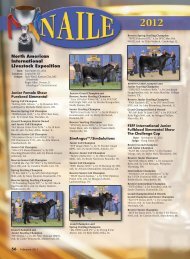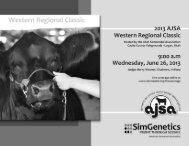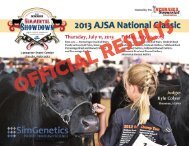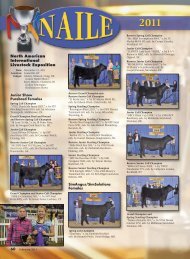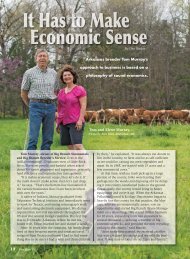Fleckvieh History 08 - American Simmental Association
Fleckvieh History 08 - American Simmental Association
Fleckvieh History 08 - American Simmental Association
You also want an ePaper? Increase the reach of your titles
YUMPU automatically turns print PDFs into web optimized ePapers that Google loves.
Many breeders have asked about the history of<br />
<strong>Fleckvieh</strong>. It is difficult, if not impossible, to find a<br />
chronological history of the breed. I have put together<br />
a brief history with the help of C.P. Massmann, past<br />
Executive Director of the South African <strong>Simmental</strong>er<br />
<strong>Association</strong>, and Dr. Thomas Grupp, General Manager<br />
of Prüf - und Besamungsstation in Munich, Germany.<br />
My sincere thanks to them for their help.<br />
Fred Schuetze<br />
<strong>Simmental</strong> cattle originated in the<br />
Simme Valley in Switzerland and have<br />
been around since the early 1800’s, and<br />
probably before, but there is little<br />
documentation. The first <strong>Simmental</strong><br />
Herdbook was established<br />
in 1890 in Bern<br />
that recorded <strong>Simmental</strong><br />
cattle which were then<br />
bred for milk, beef<br />
and draft.<br />
In the late 1800’s Swiss <strong>Simmental</strong>s were exported<br />
throughout Europe where different selection traits<br />
changed the cattle, as well as their names, and the five<br />
strains of <strong>Simmental</strong> were derived. In Germany and<br />
Austria they were called “<strong>Fleckvieh</strong>”, translated into<br />
English you have Spotted Cattle or <strong>Simmental</strong>. In the<br />
high valleys and mountains of France the “Abondance”<br />
line was started and in Southeastern France the “Montbeliard”<br />
was developed for milk production. In the rest<br />
of France the “Pie Rouge de l’Est” became known.<br />
The first documented exports outside of<br />
Europe were in 1893 and they went to Namibia.<br />
No other exports were seen until 1963 when a group<br />
was sent to Brazil and this signaled the start of the beef<br />
boom around the world. Argentina, Canada and the USA<br />
followed in 1968; the UK and Ireland in 1970; Australia,<br />
New Zealand and Uruguay in 1971; Sweden in 1973,<br />
Denmark in 1975 and Mexico in 1982.<br />
It is noted that<br />
between 1900 and 1929<br />
cattle, not watches,<br />
became the number<br />
one export product from<br />
Switzerland with over<br />
150,000 head being<br />
exported during<br />
this period.<br />
Our history has produced a genetic base that<br />
originally was based upon milk, beef and draft because<br />
economics forced these issues of importance upon our<br />
forefathers. Over the last 150 years economic traits and<br />
environments have changed our cattle to what we know<br />
them as today within the different environments.<br />
So, how have we changed in types over the last 100<br />
years in the <strong>Fleckvieh</strong> breed<br />
I will let the<br />
pictures tell<br />
the story.<br />
1890<br />
In 1905 the second documented<br />
export was sent to South Africa.<br />
1950<br />
2000<br />
42 Fullblood <strong>Simmental</strong> <strong>Fleckvieh</strong> Federation Guide
Now, where are we nearly a<br />
decade from the turn of the century<br />
In Europe, where milk is the<br />
driving force, <strong>Fleckvieh</strong> are still dual<br />
purpose cattle and selection has<br />
maintained it to be a balanced<br />
breed, not selected for the extremes.<br />
Balanced, productive and<br />
highly efficient dual purpose cattle,<br />
suitable for the production of milk,<br />
beef, and beef by-products,that can<br />
be kept in all production systems around the world.<br />
<strong>Fleckvieh</strong> were imported to North America in 1968<br />
and started the pendulum genetic swing from the cattle<br />
of the 40’s and 50’s, that were just over three feet tall, to<br />
the large framed, narrow gutless wonders of the 70’s and<br />
80’s, and then on to a trend toward smaller framed, easy<br />
fleshing, thicker cattle with less milk to stay productive<br />
on pasture land throughout the US.<br />
40’s & 50’s<br />
70’s & 80’s<br />
Summary was created in 1971 by <strong>American</strong> <strong>Simmental</strong><br />
<strong>Association</strong>, and they continue to lead the field in the<br />
pursuit of perfection.<br />
The acceptance of <strong>Fleckvieh</strong> cattle globally is because<br />
of their economic advantages and their adaptability.<br />
Crossbreeding with Dairy Breeds<br />
<strong>Fleckvieh</strong><br />
2006<br />
<strong>Fleckvieh</strong> x Jersey<br />
<strong>Fleckvieh</strong> x Holstein<br />
World<br />
Congress<br />
1978 2006<br />
What is the future of the <strong>Fleckvieh</strong> Breed<br />
Crossing with dairy breeds<br />
Performance testing of <strong>Simmental</strong><br />
cattle started in the early years and<br />
weights were a requirement for<br />
registration. The first <strong>Simmental</strong> Sire<br />
Crossing with beef breeds<br />
Dual Purpose<br />
Fullblood <strong>Simmental</strong> <strong>Fleckvieh</strong> Federation Guide 43
As one travels around the world it is easy to see<br />
why <strong>Fleckvieh</strong> have maintained such a presence in the<br />
beef cattle industry. The numbers of <strong>Simmental</strong> cattle,<br />
in the world population, is second only to Zebu. And,<br />
again, the reason is adaptability and proven genetics<br />
that are a century old.<br />
In some countries the color has changed and type<br />
has been modified to meet environmental and market<br />
demands, but the genetic base of <strong>Fleckvieh</strong> continues<br />
to provide the base for superior performance.<br />
Meeting the needs of the cattle industry<br />
Over the last 150 years <strong>Fleckvieh</strong>s have changed<br />
also to meet the demands imposed upon them by the<br />
environment and the market place. In some countries<br />
smaller framed, easy fleshing and calving with less milk<br />
and higher carcass quality are issues, along with color.<br />
While in others countries, size and color are not an issue<br />
and more milk is desirable.<br />
The key issue here is that within the <strong>Fleckvieh</strong><br />
gene pool there are genetics available to produce the<br />
type of cattle needed, and, as long as <strong>Fleckvieh</strong> breeders<br />
don’t go to extremes, the cattle will survive as they have<br />
done for the last 1 1/2 centuries.<br />
South Africa<br />
South America<br />
Current <strong>Fleckvieh</strong> Types<br />
Europe<br />
Australia and New Zealand<br />
USA<br />
Moderate Size — Easy Calving — With Depth Of Rib<br />
Good Udders With Adequate Milk — Natural Thickness<br />
Sound Feet And Legs — Carcass Quality<br />
44 Fullblood <strong>Simmental</strong> <strong>Fleckvieh</strong> Federation Guide


